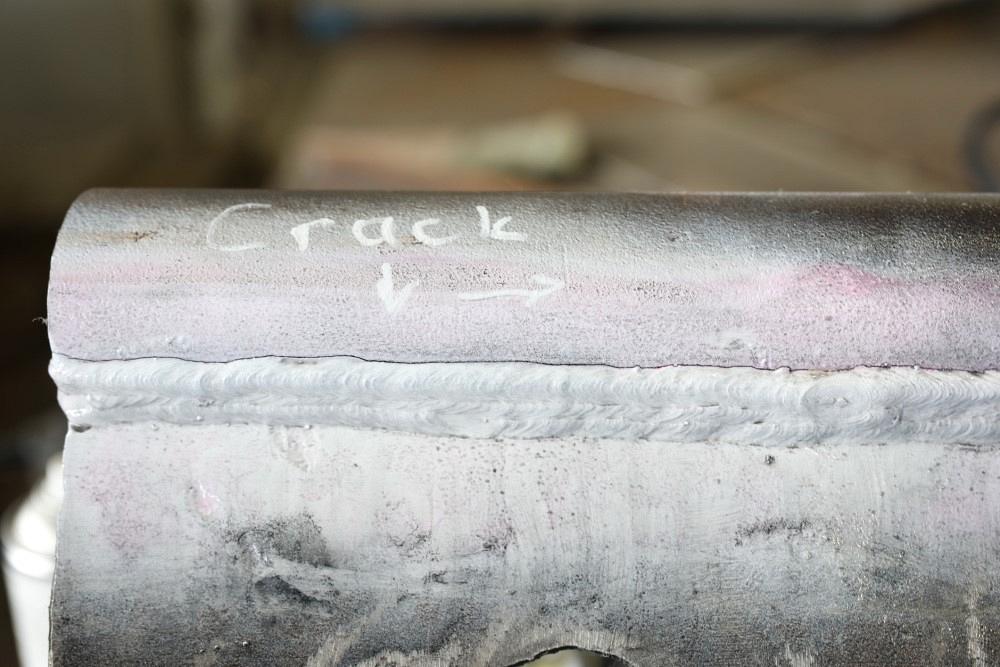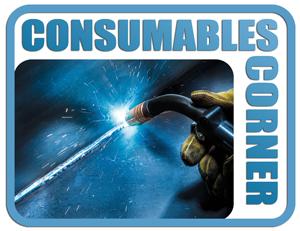Independent welding consumables professional
- FMA
- The Fabricator
- FABTECH
- Canadian Metalworking
Categories
- Additive Manufacturing
- Aluminum Welding
- Arc Welding
- Assembly and Joining
- Automation and Robotics
- Bending and Forming
- Consumables
- Cutting and Weld Prep
- Electric Vehicles
- En Español
- Finishing
- Hydroforming
- Laser Cutting
- Laser Welding
- Machining
- Manufacturing Software
- Materials Handling
- Metals/Materials
- Oxyfuel Cutting
- Plasma Cutting
- Power Tools
- Punching and Other Holemaking
- Roll Forming
- Safety
- Sawing
- Shearing
- Shop Management
- Testing and Measuring
- Tube and Pipe Fabrication
- Tube and Pipe Production
- Waterjet Cutting
Industry Directory
Webcasts
Podcasts
FAB 40
Advertise
Subscribe
Account Login
Search
Consumables Corner: How to diagnose and prevent weld cracking
- By Nino Mascalco and Rob Koltz
- October 28, 2020
- Article
- Consumables
Q: I work for a pressure vessel fabricator and we are experiencing weld cracking when welding 1½-in.-thick carbon steel. It’s happening all year long regardless of what welding process we use. Do you have any ideas as to why that is?
A: The key to solving these cracking problems is to first identify what’s causing them. That sounds easy enough to do, but that is not always the case. In this column we won’t discuss all of the cracking mechanisms, but instead we’ll develop an understanding of why cracking occurs.
The first thing to realize is that 98% of all weld cracks are either cold cracks or hot cracks. The other 2% are caused by things such as arc blow, material contamination (generally oil-based), plate laminations, fatigue, a base metal’s heat-affected zone, or weld metal solidification cracking. Some of these other cracks are generally the result of using the wrong welding technique or filler metal.
A cold crack forms after the weld metal has become cold, that is, has cooled below 200 degrees F. This type of crack is delayed in forming and may take up to 72 hours to appear. It generally occurs because of hydrogen embrittlement or residual stresses that exceed the strength of the filler metal or base materials.
A hot crack starts to form while the weld metal is solidifying, typically while the weld is anywhere from 1,000 to 1,300 degrees F. Once formed, these weld cracks are known to propagate, meaning they grow until the conditions are alleviated. This type of cracking mechanism is a serious problem.
Once you identify that a crack exists, either through visual inspection or another non-destructive method, the next thing you need to do is look at the orientation of the crack within the weld metal. Are the cracks transverse (across the weld) or longitudinal (down the center of the weld)? The crack’s orientation tells the story.
Let’s discuss the causes of each crack and how to fix them.
Cold/Stress Crack. For a cold crack to form, the weld must have three things:
- Residual weld stress
- A source of hydrogen/moisture
- Presence of martensite (martensite formation can happen when the base material has a susceptible microstructure, chemistry makeup, and accelerated cooling rates)
Looking at these three points, you should immediately realize that some residual weld stress is inherent and therefore cannot be eliminated. However, we can resolve the cracking problem by addressing the other two points.
The first is hydrogen. Water’s hydrogen and oxygen atoms break apart due to the arc’s extreme heat, which can cause the hydrogen to become trapped in the steel's microstructures. You can address this by using low-hydrogen electrodes or flux and ensuring that these materials are being handled in an appropriate manner per the manufacturer’s recommendations.
Next, make sure the material’s surface is dry before you weld. Due to the nature of dew points and ambient temperatures, the easiest way to verify that the material is dry is to simply apply a flame to the surface and wait until the moisture that collects from the flame evaporates. A common mistake is using the first pass of a multipass weld to preheat the steel. This is the worst thing you can do as this technique just locks the hydrogen into the weld metal structure to get distributed throughout the entire weld.
The other method to prevent cracking is to stop the formation of martensite. Martensite forms as the result of rapid cooling and solidification of the weld metal, which is why you should apply a sufficient amount of preheat on the adjacent base metal to slow the cooling rate.
For example, if we are making a weld on 1½-in.-thick carbon steel, we need to have a sufficient amount of preheat on the adjacent base material of 200 degrees F or more, depending on the carbon equivalency of the base material. This preheat keeps the adjacent material from drawing the heat out of the weld metal, resulting in accelerated weld cooling.
Hot Crack. A hot crack forms as the weld metal is solidifying and is always longitudinal to the weld itself. The weld metal has an insufficient amount of strength to overcome or withstand shrinkage as the result of the cooling through the temperature range described previously. This type of cracking is typically associated with fillet welds, especially when welding the second side of a T-joint configuration. It also happens on groove joints, generally the first root pass.
For a hot crack to form, the weld must have one or more of the following:
- Compounds with low melting points or contaminants in the weld metal
- An overconstrained weld joint (too much bracing) and/or poor joint fit-up
- A filler metal with the incorrect strength, insufficient weld size, and the wrong shielding gas for FCAW
- An improper welding technique or poor welding parameters
- Insufficient or an absence of preheat
Low-melting-point compounds are not very common since filler metals are held to rigorous standards by U.S. manufacturers. The base materials can have problems because some suppliers in the global supply chain have poor quality control standards.
Overconstrained joints are pretty commonplace. Having sufficient bracing to maintain dimensional tolerance is important. Poor joint fit-up that creates excessive gaps will generate a large amount of weld shrinkage stress.
Having the correct filler metal strength and proper weld size is necessary to overcome the residual weld shrinkage stresses. If you use FCAW, make sure your shielding gas is correct per the AWS classification and manufacturer's recommendations. A high-argon shielding gas with a wire designed for carbon dioxide will only cause too much alloy recovery in multipass welds, and that can lead to cracking.
Incorrect welding parameters and poor technique can lead to cracking. A technique that produces a concave weld bead lacks enough weld reinforcement in the throat of the weld to overcome the shrinkage stresses.
Use a preheat on heavier sections of base materials or where there is a large heat-sink to slow the cooling rate, reducing weld shrinkage stress and preventing cracking.
About the Authors


Rob Koltz
Application Engineer
411 S. Ebenezer Rd.
Florence, 29501
636-485-2253
About the Publication
Related Companies
subscribe now

The Welder, formerly known as Practical Welding Today, is a showcase of the real people who make the products we use and work with every day. This magazine has served the welding community in North America well for more than 20 years.
start your free subscription- Stay connected from anywhere

Easily access valuable industry resources now with full access to the digital edition of The Fabricator.

Easily access valuable industry resources now with full access to the digital edition of The Welder.

Easily access valuable industry resources now with full access to the digital edition of The Tube and Pipe Journal.
- Podcasting
- Podcast:
- The Fabricator Podcast
- Published:
- 04/16/2024
- Running Time:
- 63:29
In this episode of The Fabricator Podcast, Caleb Chamberlain, co-founder and CEO of OSH Cut, discusses his company’s...
- Trending Articles
Sheffield Forgemasters makes global leap in welding technology

Welding student from Utah to represent the U.S. at WorldSkills 2024

Lincoln Electric announces executive appointments

Engine-driven welding machines include integrated air compressors

ESAB unveils Texas facility renovation

- Industry Events
16th Annual Safety Conference
- April 30 - May 1, 2024
- Elgin,
Pipe and Tube Conference
- May 21 - 22, 2024
- Omaha, NE
World-Class Roll Forming Workshop
- June 5 - 6, 2024
- Louisville, KY
Advanced Laser Application Workshop
- June 25 - 27, 2024
- Novi, MI




























